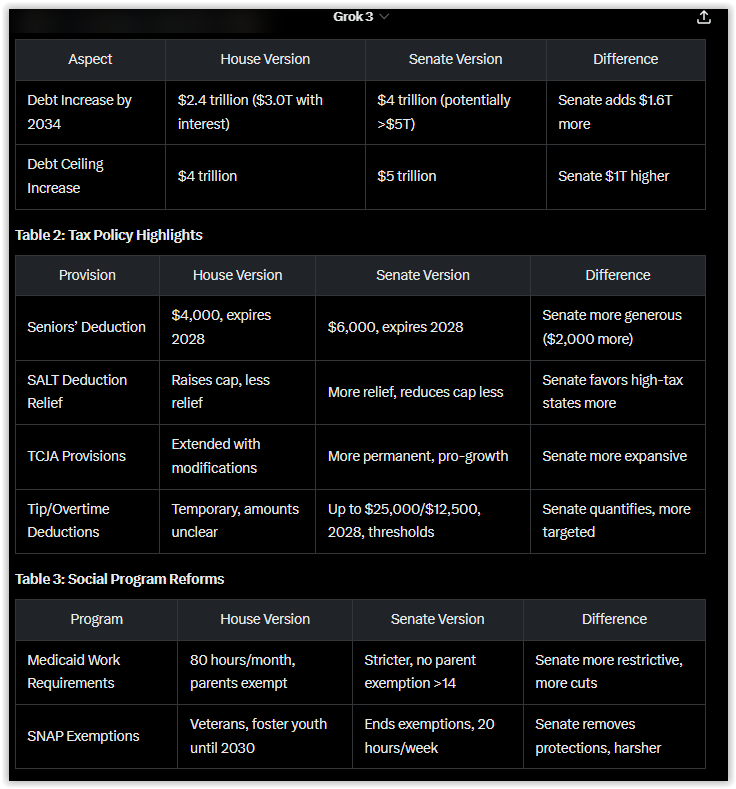UPDATED: The OBBB Comparison & Vote-A-Rama
House vs Senate as of 06.30.25
We asked X GROK to compare and list the differences between the latest House version of HR1 OBBB to the latest Senate version.
We opted for Deep Search.
Analysis
NOTE - The updated CBO Markup from 06.28.25 was NOT available at the time of this analysis. It was based on the budget estimate from 06.27.25.
The Vote-A-Rama*
America Mission has been streaming the Senate Floor Session since 06.28.25. Since it was agreed 51 - 50 to move Senate Floor for a Vote on the OBBB, Senator Schumer got ‘his way’ and the entire bill is currently being read. At the time of the post, the reading is reaching the 14 hour mark.
==> Vote-A-Rama Amendment Tracker
You can access the recorded stream here on the following platforms:
The First 24 hrs
Part Two 06.29-30.25
Part Three 06.30.25
*What Is Vote-A-Rama?
Vote-a-rama is a fast-paced phase in the U.S. Senate during budget reconciliation bills, like the One Big Beautiful Bill. After the 20-hour general debate ends, senators can propose unlimited amendments, which are debated briefly (one to two minutes per side) and voted on rapidly, often for hours or overnight.
Amendments must be budgetary per the Byrd Rule** and require a simple majority to pass. It’s a mix of policy adjustments and political strategy, with parties using amendments to shape the bill or force tough votes. For OBBB, the vote-a-rama began late June 29, involving senators like Murkowski and Schumer, and extends into June 30.
**The Byrd Rule is a U.S. Senate rule that governs the content of budget reconciliation bills, such as the One Big Beautiful Bill (OBBB) debated on June 29, 2025. It ensures that reconciliation, a fast-track legislative process bypassing the 60-vote filibuster threshold, stays focused on budgetary matters and doesn’t include extraneous provisions. Below is a concise, high-level summary of the Byrd Rule’s details, tailored to your interest in the OBBB and the vote-a-rama process.
The Byrd Rule is critical:
Amendment Scrutiny: Senators like Lisa Murkowski (R-AK), Susan Collins (R-ME), or Chuck Schumer (D-NY) proposed amendments on taxes, Medicaid, or deficits. Each had to directly affect the budget (e.g., altering tax rates or spending levels) to survive Byrd Rule challenges.
Examples of Excluded Amendments: Amendments on non-budgetary issues, like immigration policy or environmental regulations, would likely be struck. For OBBB, a Democratic amendment on healthcare access might be rejected if its fiscal impact was deemed incidental.
Strategic Implications: Both parties craft amendments to comply with the Byrd Rule while advancing policy or political goals. Democrats, in the minority, might have proposed amendments to highlight OBBB’s $3.3 trillion deficit impact, ensuring fiscal relevance to pass muster.
How to Track OBBB’s Vote-a-Rama
To see the exact amendments and votes from OBBB’s vote-a-rama:
Congressional Record: Check the June 29-30, 2025, Senate proceedings on Congress.gov or GovInfo.gov for a list of amendments, sponsors, and vote outcomes.
C-SPAN: Watch archived Senate floor coverage for June 29-30, 2025, showing amendment debates and votes.
Senate Budget Committee: Their website may summarize reconciliation amendments.





